
Bristol UK Postcards
Observatory
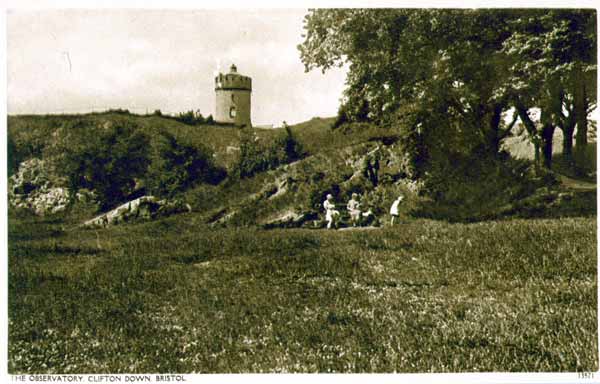
The Observatory
This unused postcard has the printed text...
13571
Printed in Gt. Britain
"We shall continue steadfast in
faith and duty till our task is done."
The Prime Minister
The quote is from Winston Churchill's speech given to allied delegates at St. James's Palace on June 12th, 1941. The speech runs "Our air power will continue to teach the German homeland that war is not all loot and triumph. We shall aid and stir the people of every conquered country to resistance and revolt. We shall break up and derange every effort which Hitler makes to systematize and consolidate his subjugations. He will find no peace, no rest, no halting place, no parley. And if, driven to desperate hazards, he attempts invasion of the British Isles, as well he may, we shall not flinch from the supreme trial. With the help of God, of which we must all feel daily conscious, we shall continue steadfast in faith and duty till our task is done."
I have another copy of this postcard that has the quote...
"This is a time for everyone to stand to-gether and hold firm."
This quote is from Winston Churchill's Broadcast to the Nation on 11th September 1940.
The Observatory was originally built as a Snuff Mill, the windmill was destroyed by fire in 1777, but was rebuilt in 1829 by a Mr West who installed the Camera Obscura in the tower. This is an arrangement of mirrors and lenses that projects an image onto a circular table. By turning a handle different parts of the city can be bought into view, giving a 360-degree, panoramic view. The circular part of the building houses the entrance to the Giant's Cave. This is a passageway that leads to an opening in the face of the gorge. A metal grating lets you walk out a couple of feet into the gorge which can be very disconcerting.
The Observatory stands on the edge of Durdham Downs. This is 180 hectares (422 acres) of park and woodland that sits on top of the gorge. Originally belonging to the Manor of Clifton the land was purchased by the Merchant Venturers in the seventeenth century. In 1861 it was preserved by an Act of Parliament as an open space for the use of the inhabitants of Bristol, forever. Sheep were grazed here until 1924, the owner of the Clifton Down Hotel even complained that the noise of the sheep disturbed his guests.
Pageant
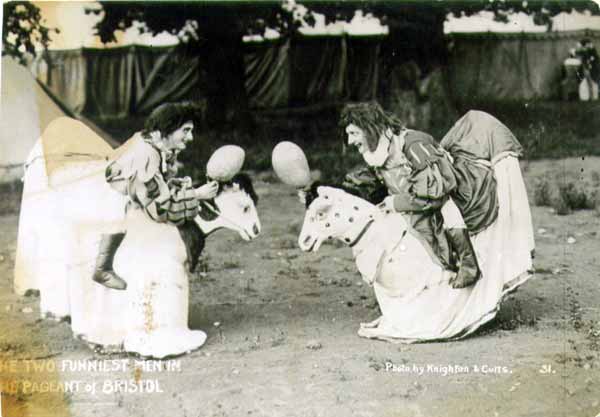
"The Two Funniest Men in the Pageant of Bristol"
This unused postcard has the printed text...
31
Photo by Knighton & Cutts
Bristol has had many pageants over the years in various parts of the city, usually on Durdham Down or Ashton Court. The two men here wearing hobby horses are recreating one of the many old traditions at these pageants. There are several versions of how the hobby horse came about. One is that they recreate the knights of old, for example, one version has St. George, the patron saint of England riding a hobby horse to kill a dragon. Another version says that the hobby horses recreate the riders who used to stand on the coasts waiting to warn of an impending invasion. Yet another version says that the hobby horses are an old fertility rite. Sometimes the riders would cover a young woman or girl with the skirts of the hobby horse.
Park Street
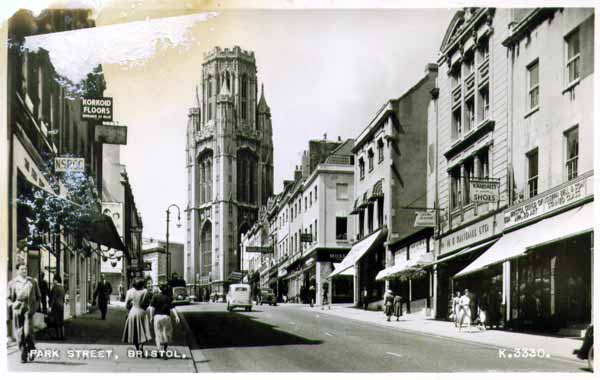
Park Street
This unused postcard has the printed text...
K.3330
Printed in Gt. Britain
Valentine & Sons Ltd., Dundee and London
Valentine's trademark logo
This is a Real Photograph
Sending you greetings
The large building at the top of Park Street is Bristol University's Will's Memorial Building. Under the Korkoid Floors and Phyllosan vitamin and iron supplement adverts on the left can be seen the NSPCC store. Opposite are Moss Bros. clothing outfitters, Cairo Jewels, Leoni-Jeanne Hairdressers, H. E. Randall shoe shop, Bristol Guild of Applied Art and Joseph Bell & Son stained glass.
The development of Park Street began in 1740 when the City Council leased land to Nathaniel Day, holder of Bullock's Park to open a new street. Nothing happened until the approval in 1758 of a further design by George Tyndall for the street to connect to Whiteladies Gate, one of the turnpikes. George Tully drew up plans and building started in 1761, by Thomas and James Paty. The first phase of building finished at Great George Street around 1762. The upper part of the street was developed from about 1786 and work was suspended in the financial crisis of 1793, resumed and completed about ten years later. A cast-iron viaduct to take the street over the natural gully between College Green and Brandon Hill was built by R. S. Pope in 1871. About a third of the buildings were damaged in World War II but were mainly rebuilt.
Porcelain
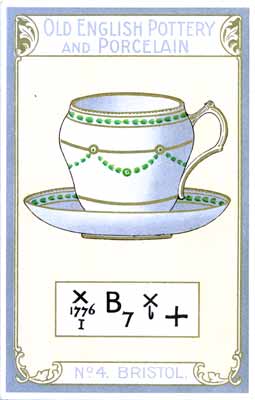
Porcelain
This unused postcard has the printed text...
Old Englsih Pottery and Porcelain
No. 4. Bristol
Chairman Cigarette Series
J. W. Locking
Cigar Merchant and Tobacconist
33 & 34, Paragon Street
Hull
Pottery was made at Bristol as early as the
reign of Edward I. Delft in 1706 and porcelain
in 1750. Works flourished under Richard Champion
from 1770 to 1777. Continued by Ring and
other proprietors till early 19th century. Bristol
porcelain in rich and creamy in paste with a
cold and glassy surface like Dresden, for which
it is often mistaken, especially when marked
with the Crossed Swords. A series of minute
pits or depressions, as in Oriental China, is
often found in the glaze. Specimen illustrated
in South Kensington Museum.
Prince's Theatre
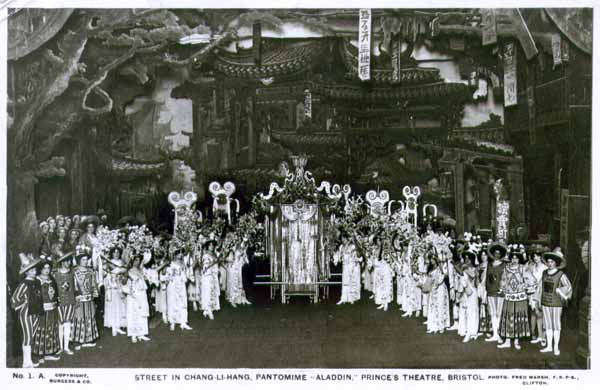
Prince's Theatre
Street in Chang Li-Hand, Pantomime "Aladdin"
This postcard, posted in Bristol on January 27th, 1909, has the printed text...
No. 1A
Copyright, Burgess & Co.
Photo. Fred Marsh F.R.P.S., Clifton
The Prince’s Theatre, Park Row, Bristol began life as the Theatre Royal. In 1866 John Henry Chute bought the site on the South side of Park row, formerly an old mansion known as "The Engineers House". The estimated cost of his completed theatre was between £12,000 and £18,000, and it opened its doors on October 14th, 1867. with a production of "The Tempest".
Chute was married to Emily Mazzarine Macready, the half sister of the famous tragedian, and their sons James Macready Chute and George Macready Chute were later to inherit the running of the building along with their mother.
When the "Royal" opened it boasted a stage 107 ft. across, and a seating capacity of 2,100 - at one time extended to 2,800 seats. Chute lavished every new invention and luxury on his building, and within a year was staving off bankruptcy.
From the beginnings the biggest financial success for the theatre was the annual pantomime - beginning with "Aladdin" in 1867 and continuing virtually unbroken through until 1940 - a total of 72 productions over as many years, making the Prince's Theatre Pantomime one of the premier pantomime houses in the country.
Electric light was installed in 1985 and afte several refurbishments in 1902 and 1907 the theatre became one of the best outside of London. The end of the theatre came on the night of November 24th 1940 when it was destroyed during a bombing raid.
Promenade, Clifton
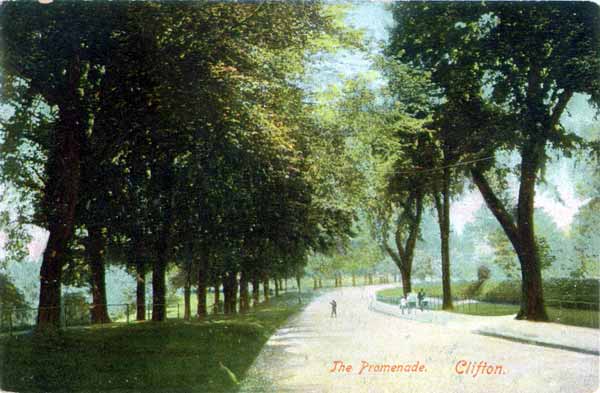
Promenade, Clifton
This unused postcard has the printed text...
No. 1331
E. S. Copyright
Printed at works in Leipzig
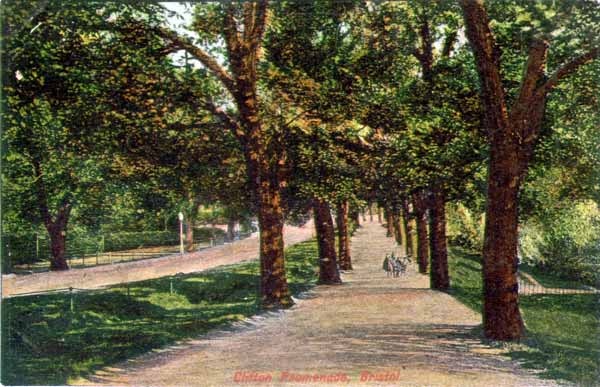
Promenade, Clifton
This unused postcard has just the printed text "Printed in Prussia"
Red Lodge
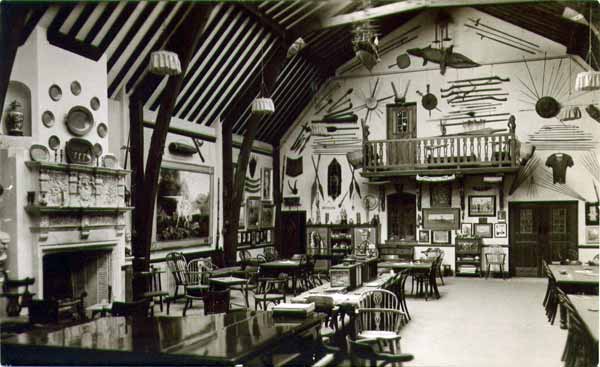
Red Lodge - Savage's WigWam
This unused postcard has the printed text...
This is a Real Photograph
Printed in Britain
The Red Lodge is situated off of Lodge Street on Park Row. Built in 1580 for John Yonge as a lodge for a Great House, which once stood on the site of the present Colston Hall. It was altered around 1730, and restored in the early 20th century by C. F. W. Dening. It is furnished in Elizabethan, Stuart and Georgian styles and contains the impressive Great Oak Room, with its original Elizabethan plasterwork ceiling, oak panelling and carved chimneypiece. The garden is set out as an impressive Elizabethan knot garden.
The house has had several uses in its past, including the country's first girls' reform school. This was set up in 1854 by Mary Carpenter, with the financial help of the poet Lord Byron's widow, who bought the Red Lodge in 1854. Mary Carpenter died in 1877 and there is a room specially set aside in her memory with a display of her life and work.
The Bristol Savages are a group of artists who have met since 1894, but it wasn't until 1904 that they took the name "Savages". When the Red Lodge came on the market in 1919, it was purchased to create headquarters for the Tribe. A lease was drawn up for the Society, after which the building was formally handed over as a gift to the City of Bristol.
The "Wigwam" was designed by one of their members, based on the lines of an old tithe barn and it was officially taken over as the Bristol Savages home on 24th April 1920.
Source: Bristol Savages
This page created 11th November 2009, last modified 10th February 2010